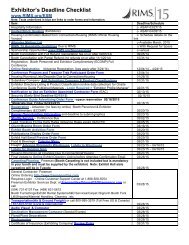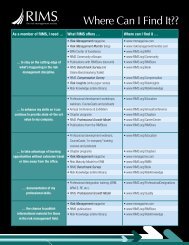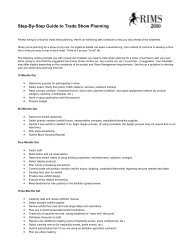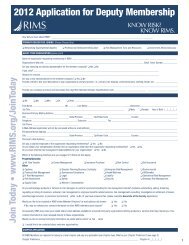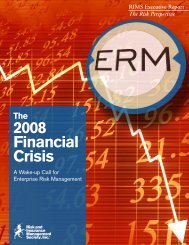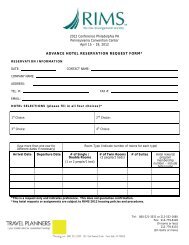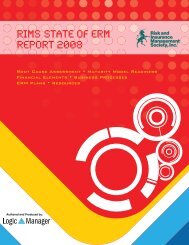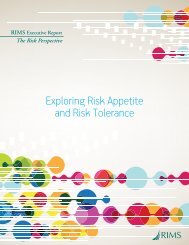The Accenture 2011 Global Risk Management Study - RIMS
The Accenture 2011 Global Risk Management Study - RIMS
The Accenture 2011 Global Risk Management Study - RIMS
You also want an ePaper? Increase the reach of your titles
YUMPU automatically turns print PDFs into web optimized ePapers that Google loves.
<strong>2011</strong> <strong>Global</strong> <strong>Risk</strong> <strong>Management</strong> Point of View Life Sciences
<strong>2011</strong> <strong>Global</strong> <strong>Risk</strong> <strong>Management</strong> Point of View Life Sciences<strong>Risk</strong> management as a source of competitiveadvantage and high performance in the lifesciences industry<strong>Risk</strong> management that enables long-term competitive advantageOne of the largest risk management executive surveysof its kind, the <strong>Accenture</strong> <strong>2011</strong> <strong>Global</strong> <strong>Risk</strong> <strong>Management</strong><strong>Study</strong> has found that senior executives across all industriesare making risk management a top priority. Companiesare investing at greater levels and are more likely to havein place C-level executive oversight to ensure that risk isbeing managed in an enterprise-wide fashion. In short, riskmanagement capabilities are not only prevalent and a targetof investments—they are also more aligned with growthstrategies and they are helping companies achieve theirmost important business priorities.Beyond the immediate pressures of global markets, moredemanding customers and dramatic industry change is agrowing recognition that companies have an opportunityto drive competitive advantage from their risk managementcapabilities, enabling long-term profitable growth andsustained future profitability.This means that risk management at the top-performingcompanies in our study is now more closely integrated withstrategic planning and is conducted proactively, with an eyeon how risk management capabilities can help a companybe successful in new markets faster or pursue other evolvingbusiness expansion opportunities to enable growth.Eight percent of the respondents in our <strong>Global</strong> <strong>Risk</strong><strong>Management</strong> <strong>Study</strong> were executives from leading lifesciences companies who have responsibility within the riskmanagement function. This report augments the global,cross industry study (for a summary, see over) with someof the compelling detailed perspectives from life sciencessurvey participants.Eight percent of the respondentsin our <strong>Global</strong> <strong>Risk</strong> <strong>Management</strong><strong>Study</strong> were executives fromleading life sciences companies
Summary findings: <strong>The</strong> <strong>Accenture</strong> <strong>2011</strong><strong>Global</strong> <strong>Risk</strong> <strong>Management</strong> <strong>Study</strong><strong>The</strong> <strong>Accenture</strong> <strong>2011</strong> <strong>Global</strong> <strong>Risk</strong> <strong>Management</strong> <strong>Study</strong> is based on aquantitative survey of executives from 397 companies across tenindustries. All respondents were C-level executives involved in riskmanagement decisions at their companies; organizations were splitprimarily among Europe, North America, Latin America and Asia Pacific.In addition to the quantitative survey, additional in-depth interviewswere conducted with a number of executives whose views are alsorepresented in the survey findings.Key risk insightsResults from the study support the following key insights related to the heightened importance of riskmanagement capabilities in meeting today’s business challenges and opportunities:1. Increasing volatility andgrowing complexity make riskmanagement central and strategic toall industries.More than 80 percent of companiessurveyed, across all industries, considertheir risk management function tobe a key capability that helps themdeal with marketplace volatility andorganizational complexity.2. Executives see their riskmanagement capabilities asimportant to future profitability andlong-term growth.Beyond its traditional role in areaslike compliance, risk management isnow seen as a driver of more strategicbusiness objectives. More than 90percent of executives see the riskmanagement function as important orcritical to growth and profitability.3. Companies are implementingcomprehensive enterprise riskmanagement programs.Companies are making smartinvestments in risk managementcapabilities. More than 80 percent ofsurvey respondents overall have anenterprise risk management (ERM)program in place or plan to have onein the next two years.4. Companies are establishingC-level oversight of the riskmanagement function.About two-thirds of all surveyrespondents (64 percent) have aChief <strong>Risk</strong> Officer operating with thattitle. Another 20 percent have anexecutive in the role fulfilling thoseresponsibilities. Thus the criticality ofrisk management is being recognizedby the way the function is staffedand led.5. Executives expect theirinvestments in risk management toincrease over the next two years.Eighty-three percent of respondentssee risk management investmentsincreasing in the next two years. Ofthose, 21 percent foresee a significantincrease (more than 20 percent) while62 percent foresee an increase of lessthan 20 percent.
Challenges aheadSurvey findings and <strong>Accenture</strong>analysis point to a number ofchallenges ahead for companieswhen it comes to managing complexrisks more effectively:• <strong>The</strong> types and magnitude ofrisks are increasing. Companieshave growing concerns about abroader spectrum of risks, includingthose related to the supply chain,operations, regulationand reputation.• Despite major investments todevelop risk capabilities, criticalexposures persist, especially in themeasurement of key risks.• Organizational silos andoutdated information systemsare preventing effective integrationof risk management structuresand responsibilities.• Companies experience performancegaps between expectations forrisk management and what isachieved. For example, 93 percentof respondents indicate that the riskorganization is important as a driverfor sustained future profitability,but only 76 percent say their riskorganization has achieved that goal.• Cost reduction and alignmentof risk management with overallbusiness strategy are ongoingexecutive concerns.Survey findings and<strong>Accenture</strong> analysispoint to a number ofchallenges ahead forcompanies when itcomes to managingcomplex risks moreeffectivelyAchieving risk mastery<strong>The</strong> large sample size of the<strong>Accenture</strong> <strong>2011</strong> <strong>Global</strong> <strong>Risk</strong><strong>Management</strong> <strong>Study</strong> enabled theidentification, with statistical validity,of a subset of companies deemedto be “<strong>Risk</strong> Masters”—companieswhose practices and capabilities setthem apart from their peers. Basedon analysis of these companies, thefollowing are key risk managementcapabilities that can help guide othercompanies toward mastery:• Look to create shareholder valuefrom risk management.<strong>Risk</strong> Masters are especially adeptat creating processes andmechanisms that link risk to businessperformance.• Involve the risk organization inkey decision-making processes.<strong>The</strong> risk managementorganization needs to beincluded in activities such asstrategic planning, objectivesetting and incentives, financingdecisions and performancemanagement processes.• Improve the sophisticationof measurement, modeling andanalytics to anticipate risks in anincreasingly complex environment.<strong>Risk</strong> Masters are more likelyto measure a fuller spectrum ofrisk types, and they have a highercommitment to analytics andrisk modeling.• Go beyond a compliance mindsetof risk management to deliver morecomplete business solutions thatdrive competitive differentiation.Top-performing companies arebetter at managing regulationand compliance in a way that alsodelivers better business performance.<strong>Risk</strong> Masters are also better atdeveloping relationships withregulatory agencies.• Integrate risk managementcapabilities across business unitsand organizational structures.Much higher percentages of <strong>Risk</strong>Masters excel at the integrationrequired for effective riskmanagement, something thatrequires a commitment to evolvingorganizational capabilities over amulti-year program of change.• Establish a dedicated, C-levelrisk executive with oversight andvisibility across the business.Top performers separate themselvesfrom the pack by having in placea dedicated risk executive withsufficient visibility and leverageto influence risk managementcapabilities across the entireorganization.• Infuse risk awareness acrossthe organizational culture.It is vital to have in place themechanism to create and distributemore broadly across the organizationan awareness of risk exposure,detailed training and the meansto mitigate risks.• Invest in continuousimprovement.<strong>Risk</strong> management is an ongoing,evolving capability. <strong>The</strong> worldchanges rapidly and companiesmust be nimble in terms of stayingahead of the curve when it comesto meeting the risks and challengesahead.To access the complete <strong>Accenture</strong><strong>2011</strong> <strong>Global</strong> <strong>Risk</strong> <strong>Management</strong><strong>Study</strong>, please go to www.accenture.com/<strong>Global</strong><strong>Risk</strong><strong>Management</strong>Research<strong>2011</strong>.12
<strong>2011</strong> <strong>Global</strong> <strong>Risk</strong> <strong>Management</strong> Point of View Life SciencesKey findings<strong>The</strong> life sciences industry—comprising pharmaceutical, biotechnologyand medical device companies—has a risk profile that is different notonly from other non-financial industries, but from other companiesin the broader healthcare industry. Regulatory issues have alwaysbeen a major concern for life sciences companies and they are amongthe most active in working with regulators to shape risk-relatedregulation. <strong>The</strong> life sciences industry also faces a broad spectrumof risks related to healthcare reform and pricing, including pricingcontrols in some jurisdictions.In light of increased globalcompetition, pricing restrictionsand other concerns, life sciencescompanies are paying greaterattention to manufacturing anddistribution. While joint marketingagreements have become relativelycommon, vendor agreementsincluding third-party sourcing add alayer of complexity and risk to whathad previously been a more or lessentirely in-house process of discovery,development and manufacturing.Detailed findings for the life sciencesindustry based on survey data andanalysis include the following:<strong>Risk</strong> management is a constantin the life sciences industryPharmaceutical companies drivevalue from discovering and patentingnew drugs, a process that inherentlyinvolves managing a broad spectrumof business, market and operationalrisks. Only 41 percent of life sciencecompany respondents said that riskmanagement is more important fortheir companies than it was two yearsago–significantly below the overallaverage of 60 percent and far below,for example, the 74 percent of bankingindustry respondents who said riskmanagement is more important than itwas two years ago. (See Figure 1.)Although the nature of the risksconfronting the life sciences industryis changing—with healthcare reformleading to changes in pricing, newthreats from counterfeiting andfraudulent drugs and regulatoryconcerns about product safety andquality—industry responses indicatethat risk management is already builtinto their businesses. In fact, lifesciences companies are planning lowerthan average levels of investment toimprove risk processes and are averagein developing supporting risk analytics.<strong>The</strong>ir traditional strengths in assessingmarkets, evaluating investments anddetermining when to stop or sell inthe product lifecycle helps explainthese companies’ attitudes towardthe importance of risk managementand the relative maturity of theirrisk programs, including their riskgovernance and assessment processes.More integrated, comprehensiveenterprise risk management isneededAlthough survey responses indicatea high level of confidence by riskexecutives in the life sciences industry,these companies are more likely thanothers (30 percent versus 18 percent)to take a non-integrated or “siloed”approach to assessing business risks,often due to the great diversity ofproducts produced and servicesprovided to customers. Although riskmanagement programs in the lifesciences address operational risks, theydo so less frequently than in otherindustries. For example, life sciencescompanies most often address pricingissues as a point of discussion amongexecutives and the board of directors(53 percent).Our global research findings show thatintegration is a key to achieving riskmastery, so the findings related to lifesciences should spark discussion about
<strong>2011</strong> <strong>Global</strong> <strong>Risk</strong> <strong>Management</strong> Point of View Life SciencesFigure 1Because risk management is a constant presence in the life sciences industry,executives do not feel it is a higher priority today than it has beenIs risk management a higher priority for your company now than it was two years ago?74%69% 68%65% 64%60%58%54%51%49%41%Banking Insurance Utilities CapitalMarketsHealthcare Average Comms andHigh TechEnergy Retail ConsumerGoods andServicesLifeSciencesYes, to a great extentFigure 2Life sciences risk executives are mostly confident that they address bothoperational and financial risksDoes your risk management program address operational risks as effectively as financial risks?6%28%66%Don’t knowNoYesSample: Life Sciences respondents
<strong>2011</strong> <strong>Global</strong> <strong>Risk</strong> <strong>Management</strong> Point of View Life Scienceshow to invest in more comprehensiveenterprise risk management. <strong>The</strong> levelof risk integration is higher amongthe <strong>Risk</strong> Masters, who are far morelikely to describe numerous riskcategories as “highly integrated.” Forexample, 64 percent of <strong>Risk</strong> Mastersdescribe business risks as being highlyintegrated, compared with only 37percent of non-<strong>Risk</strong> Masters.A large majority (78 percent) of lifesciences companies address both legaland intellectual capital risks withintheir risk management programs. Eventhough operational risks are addressedless frequently than other industries,nearly two-thirds (66 percent) of lifesciences companies believe that theirrisk management companies addressoperational risks as effectively asfinancial risks, and a large majority saythey address supply chain risks withintheir risk management programs. (SeeFigure 2.)Greater visibility for riskmanagement leadership is neededEighty-five percent of life sciencescompanies have an executiveperforming the role of Chief <strong>Risk</strong> Officer(CRO) but are less likely than othercompanies to have an executive with aformal CRO title (53 percent versus thesurvey average of 64 percent). <strong>The</strong>y aremore likely than other non-financialcompanies to have a centralized riskfunction (59 percent versus 44 percent)but at a level below executive.Our research has found that oneway <strong>Risk</strong> Masters are separatingthemselves from the pack is by havinga risk executive highly placed in thecompany—one with broad oversightbut also with broad visibility andinfluence and backed by a dedicatedrisk management organization. Thiscan ensure that risk and performancemanagement are being conductedin a more strategic manner. This riskexecutive should be closely connectedto the top leadership of the company,ensuring that risk investments arestrategic and that a more proactive riskmanagement culture is created andsustained.<strong>Risk</strong> Masters are more likely to haverisk management owned by a Chief<strong>Risk</strong> Officer—55 percent compared to43 percent among other participants.<strong>Risk</strong> Masters are also more likely tohave a risk executive with the CRO title(81 percent versus 62 percent). Thismay indicate that <strong>Risk</strong> Masters morereadily acknowledge the importance ofcentralized leadership, with a C-levelexecutive as an influential part of topmanagementIncreases in regulatory risk areexpectedAcross all industries, 89 percent ofrespondents indicated that theircompany’s regulatory risk will increasein the next two years, with over onethirdsaying it is increasing significantly.An even higher percentage of lifesciences respondents (94 percent)expect an increase in regulatory riskover the next two years. However, only28 percent of respondents recognizedhealthcare reform as a driver ofother risks such as pricing. Mostcompanies address healthcare reformas a management discussion item (50percent) and as a topic to be reportedby risk management (50 percent).One of the specific related tacticsat which <strong>Risk</strong> Masters excel is inimproving relationships with regulatoryagencies. Over half of the total numberof survey respondents (54 percent)noted that it is very important todevelop relationships with regulatoryagencies for future reform. In addition,68 percent are actively establishingdirection for reform. Among <strong>Risk</strong>Masters, however, that number rises to88 percent.Financial fraud and crime aregrowing concernsNinety-three percent of surveyrespondents indicate that financialcrime and fraud are more challengingto address than two years ago, and57 percent say this is true “to a greatextent.” Life science respondents alsoreport increased concern in fraud andcounterfeit products, where companieshave experienced greater numbers offraudulent drugs, product losses due totheft and regulatory scrutiny related toboth issues.Companies are pursuing a widerange of initiatives to address theserisks, including prevention training,improving technology and improvingdata analytics. A greater share of <strong>Risk</strong>Masters also have ongoing measuresto address more sophisticated financialcrime. In addition to preventivemeasures, companies are alsoperforming root-cause analyses toprevent future instances of fraud andcrime from occurring.<strong>Risk</strong> measurement is relativelymature, though risks in emergingmarkets need more attentionAmong non-financial services and nonresourcesorganizations, life sciencescompanies are most likely to currentlymeasure operational, credit, politicaland reputational risks and least likelyto measure legal risks. Emergingmarketrisks are typically identifiedby geography and are addressedaccordingly. (See Figure 3.)Life science companies are also proneto emerging risks. A recent <strong>Accenture</strong>report on emerging risk—“Confrontingthe Unknown: How FinancialInstitutions Can Manage Emerging<strong>Risk</strong>”—details the kinds of planningand preparation needed to handlenew types of risks, which are oftennot well measured or well understood.Some of these risks are those withouthistorical precedent, such as a terroristattack. Another type takes the formof a recognized risk that exceedscommonly anticipated “worst case”scenarios, such as the price of oilreaching US$200 per barrel. Such risks,when they materialize, can damageorganizations’ finances, reputations,strategies and operations.Due to the systemic nature ofemerging risk, and the severe potentialimpact of such events, life sciencecompanies with slight advantages indetecting and managing emergingrisks can obtain significant competitiveopportunities.
<strong>2011</strong> <strong>Global</strong> <strong>Risk</strong> <strong>Management</strong> Point of View Life SciencesFigure 3Relatively few companies are addressing emerging-market risk in a distinctfashionHow are the risks related to emerging markets addressed within your risk management program?<strong>The</strong> various risks more common inemerging markets are identified bygeography and managed accordingly56%Emerging-market risk is addressedas a distinct risk28%Emerging-market risks are not addressed13%Don’t know3%Sample: Life Sciences respondents<strong>Accenture</strong> holds that it is vital foremerging risks to be integrated intoa company’s existing enterprise riskmanagement framework. To do so,these risks should be considered as partof the strategic planning process, witha direct link to top-down risk appetite.Companies are well positionedto turn risk management into acompetitive differentiatorOur research has found that <strong>Risk</strong>Masters are more likely to see the riskfunction as a driver of competitiveadvantage. Almost two-thirds of <strong>Risk</strong>Masters (64 percent) indicate that theirrisk management capabilities providecompetitive advantage to “a greatextent,” compared with only 42 percentof the peer set. <strong>Risk</strong> Masters are alsomore likely to identify risk as a higherpriority.Life sciences survey respondents saidthat the key factors for transformingrisk management into a competitivedifferentiator in their industry includeregularly and proactively identifyingnew risks (91 percent) and ensuring abalance of risk and return (88 percent).Life sciences companies are more likelythan other companies to enhancethe risk organization by focusing onorganization development and processre-engineering.Within life sciences companies, therisk function is somewhat less likelythan the overall industry averageto be involved in the performancemanagement process (72 percentversus 89 percent). Life sciencescompanies believe that the twomost important challenges in riskmanagement over the next two yearsare aligning with the overall businessstrategy (56 percent) and reducingoverall costs (50 percent).Our research hasfound that <strong>Risk</strong>Masters are morelikely to see therisk function as adriver of competitiveadvantage.
<strong>2011</strong> <strong>Global</strong> <strong>Risk</strong> <strong>Management</strong> Point of View Life SciencesTaking action: achieving risk masteryOur analysis of survey responses and our experience with globallife sciences firms point to several actions companies can taketo enhance their risk management capabilities and createcompetitive advantage.1. Focus sufficient attention andresources on operational risks.Due to the nature of the life sciencesindustry, a flaw in the manufacturingprocess can cause serious damageto regulatory compliance, safety andreputation—and, ultimately, to revenues.2. Expand awareness of supply chainrisk.Life sciences companies are increasinglydependent upon vendors, and, in turn,on those vendors’ own vendors. It ismore important than ever to be able tomap out weak spots in the supply chainand to develop responses if problemsemerge anywhere in that chain.3. Manage risk holistically and in amore integrated fashion.Instead of managing the risks ofprocurement, logistics, distribution andmanufacturing separately, companiesshould take a more network-wide view.This can enable them to see how adecision in one functional or operatingarea may affect the entire organization.4. Explore leading analytics andmeasurement tools.Companies in the life sciences industryact quickly and spend readily to improvethe clinical trial process or to complywith new regulations. Readily availabletools such as advanced analytics andscenario planning, however, can helplife sciences companies anticipate andrespond to events that are well outsidetheir normal range of experience.Life sciences companies that areable to master a range of integratedelements—involving risk managementin key decision-making processes,putting in place leadership withboard-level visibility and infusing riskawareness across the organization—are creating the means to differentiatethemselves from the competition.<strong>The</strong> <strong>Risk</strong> Masters have set a very highbar: they are looking beyond reactive,compliance-oriented mindsetsand are seeking, through their riskmanagement investments, to createshareholder value and achieve highperformance.
About the authorsSteve CulpSteve is the managing director – <strong>Accenture</strong> <strong>Risk</strong> <strong>Management</strong>. Based in London,Steve has 20 years of global experience in strategy definition, risk management,enterprise performance management and delivering large scale finance operationsengagements. Prior to his current role, Steve was the global lead for <strong>Accenture</strong>’sFinance & Performance <strong>Management</strong> consulting services for global banking,insurance and capital markets institutions. With his extensive risk managementand performance management experience and business acumen, Steve guidesexecutives and their teams on the journey to becoming high-performancebusinesses. You can contact Steve at: steven.r.culp@accenture.comMichael ChagaresMichael is an executive director – <strong>Risk</strong> <strong>Management</strong>, cross industry, Washington,D.C. With more than 20 years of experience as a consultant and banker, Michaelprovides business and enterprise risk management services to large companiesin a variety of industries including healthcare, pharmaceuticals, biotech,manufacturing, construction engineering, hospitality and real estate.His specialization in Enterprise <strong>Risk</strong> <strong>Management</strong> (ERM) and extensive experiencein assisting clients design, develop and implement customized ERM frameworksand infrastructures helps them become high-performance businesses. You cancontact Michael at: michael.chagares@accenture.comKen HooperKen is a senior manager – <strong>Risk</strong> <strong>Management</strong>, based in Washington, D.C. Overthe last eight years, Ken has provided risk management consulting servicesspecializing in large corporations, across industries. Ken has deep experience inthe risk and capital management spaces and extensive capabilities in the areasof risk governance, assessment, quantification and reporting. Prior to his work inrisk management, Ken headed the corporate treasury, market and credit risk, andenterprise risk management functions at a large U.S. utility. You can contact Kenat: kenneth.hooper@accenture.com<strong>2011</strong> <strong>Global</strong> <strong>Risk</strong> <strong>Management</strong> Point of View Life Sciences
About <strong>Accenture</strong> <strong>Risk</strong> <strong>Management</strong><strong>Accenture</strong> <strong>Risk</strong> <strong>Management</strong> consulting services works with clients to create andimplement integrated risk management capabilities designed to gain higher economicreturns, improve shareholder value and increase stakeholder confidence.About <strong>Accenture</strong><strong>Accenture</strong> is a global management consulting, technology services and outsourcing company, withmore than 223,000 people serving clients in more than 120 countries. Combining unparalleledexperience, comprehensive capabilities across all industries and business functions, and extensiveresearch on the world’s most successful companies, <strong>Accenture</strong> collaborates with clients to help thembecome high-performance businesses and governments. <strong>The</strong> company generated net revenues ofUS$21.6 billion for the fiscal year ended August 31, 2010. Its home page is www.accenture.comVisit the <strong>Accenture</strong> <strong>Risk</strong> <strong>Management</strong> Research microsite:www.accenture.com/<strong>Global</strong><strong>Risk</strong><strong>Management</strong>Research<strong>2011</strong>Take the <strong>Accenture</strong> <strong>Risk</strong> <strong>Management</strong> diagnostic:www.accenture.com/<strong>Global</strong><strong>Risk</strong><strong>Management</strong>Diagnostic<strong>2011</strong>If you have a QR reader installed onyour smartphone, simply scan this codeto be taken directly to the <strong>Accenture</strong><strong>Risk</strong> <strong>Management</strong> Research Microsite.Copyright © <strong>2011</strong> <strong>Accenture</strong>All rights reserved.<strong>Accenture</strong>, its logo, andHigh Performance Deliveredare trademarks of <strong>Accenture</strong>.



